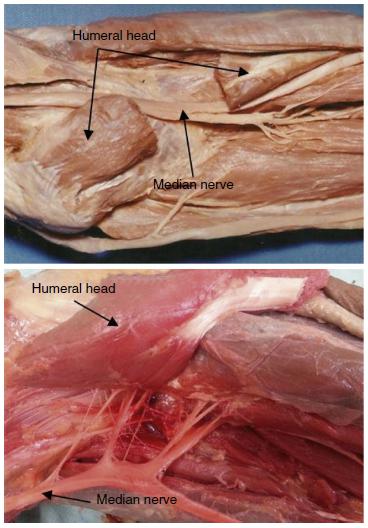ABSTRACT
OBJECTIVE:
To assess the anatomical variations of the pronator teres muscle (PTM) and its implication in the compression of the median nerve, which passes through the humeral and ulnar heads of the PTM.
METHODS:
For the present study, 100 upper limbs from human cadavers from the anatomy laboratory were dissected. Forty-six specimens were male and four, female, whose aged ranged from 28 to 77 years; 27 were white and 23, non-white. A pilot study consisting of six hands from three fresh cadaver dissections was conducted to familiarize the authors with the local anatomy; these were not included in the present study.
RESULTS:
The humeral and ulnar heads of PTM were present in 86 limbs. In 72 out of the 86 limbs, the median nerve was positioned between the two heads of the PTM; in 11, it passed through the muscle belly of ulnar head of the PTM, and in three, posteriorly to both heads of the PTM. When both heads were present, the median nerve was not observed as passing through the muscle belly of the humeral head of PTM. In 14 out of the 100 dissected limbs, the ulnar head of the PTM was not observed; in this situation, the median nerve was positioned posteriorly to the humeral head in 11 limbs, and passed through the humeral head in three. In 17 limbs, the ulnar head of PTM was little developed, with a fibrous band originating from the ulnar coronoid process, associated with a distal muscle component near the union with the humeral head. In four limbs, the ulnar head of the MPR was represented by a fibrous band. In both limbs of one cadaver, a fibrous band was observed between the supinator muscle and the humeral head of the PTM, passing over median nerve.
CONCLUSION:
The results suggest that these anatomical variations in relationship median nerve and PTM are potential factors for median nerve compression, as they narrow the space through which the median nerve passes.
Keywords:
Pronation; Median nerve; Nerve compression syndromes







